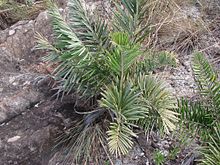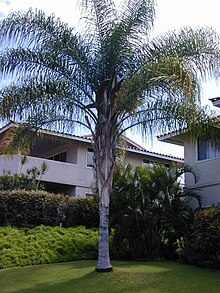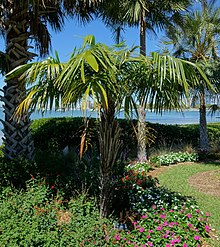Syagrus
| Syagrus | ||||||||||||
|---|---|---|---|---|---|---|---|---|---|---|---|---|
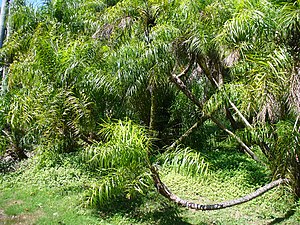
|
||||||||||||
| Systematics | ||||||||||||
|
||||||||||||
| Scientific name | ||||||||||||
| Syagrus | ||||||||||||
| Mart. |
Syagrus is a palm genus native to South America and the Antilles. The genus is very variablein shape and other features.
features
Syagrus is a very variable genus. The palms are small to large, single-stemmed or in groups, rarely branched underground. They are unreinforced or reinforced. They bloom several times and are single-sexed ( monoecious ). The trunk can be very short and underground, or erect and tall. It is seldom like a Stolon . Sometimes it's swollen at the base. The end of the trunk close to the crown is covered by the remains of the leaf bases, the other parts are lightly striped and provided with leaf scars, which can be inconspicuous, but also raised or impressed.
The chromosome number is 2n = 32.
leaves
The leaves are pinnate and arranged in a spiral. The leaf scars are circular and stand in five rows. The leaves fall off with a smooth stigma or remain dead on the plant (marzescence). The leaf sheath dissolves into a tangled mass of fibers. The petiole is very short to long, its edges are smooth or have short fibers, rarely coarse, prickly fibers. The leaf surfaces are bare, hairy, scaly or waxy. The rachis is straight or curved, short to long, and also scaly, hairy or glabrous. The few to very numerous leaflets are simply folded and are arranged regularly or irregularly on the rhachis. They are on one or more levels. They are linear, stiff or curved, the tips are pointed, pointed or blunt. The top of the blade is bare or covered with a few scales or hairs, sometimes waxy. The underside is usually noticeably hairy along the main nerves.
Inflorescences
The inflorescences are single and between the leaves (interfoliar). They are rarely spike-shaped , but usually simply branched. They are significantly shorter than the foliage leaves. The peduncle is elliptical in cross section, short or long, glabrous or hairy or scaled in various ways. The cover sheet is usually hidden within the leaf sheaths, tubular, flattened, two-keeled and torn at the tip. As it ages, it becomes fibrous and disintegrates. The bract on the peduncle is persistent and significantly longer than the previous leaf. Usually it starts directly above the cover sheet. It is Rohrig and includes the inflorescence to shortly before the anthesis . Very rarely it is shorter than the inflorescence. It is often fusiform before it rips open lengthways. It usually becomes woody, less often it is thin, leathery or paper-like.
The inflorescence axis is usually shorter than the stem or almost the same length. It is bald or hairy and carries the flower-bearing side axes (rachillae) in a spiral arrangement. Each rachilla stands in the armpit of a short, triangular, mostly leathery bract . The few to numerous rachillae are short or long, slender, straight or often twisted in the bud, often zigzag-shaped. They are bald or not very hairy. On the rachilla there are the flower triads in a spiral arrangement, in the distal sections there are paired or single male flowers. The flower groups are usually seated in the axilla of an inconspicuous bract. The flower bracts are tiny.
blossoms
The male flowers are mostly asymmetrical. The three sepals are triangular, free and imbricat or briefly fused together. They are seldom grown together to form a stem-like base. The three petals are free, valvate and thin-leathery or fleshy. They are much longer than the sepals, their shape is lanceolate, oblong or oval with a pointed end. They are bald, hairy, scaled or spotted. The six stamens have free filaments, or these are briefly fused. The filaments are short and fleshy. The anthers are elongated, dorsifix near the base or medifix. They are latrors or intrors. The rudiment of the stamp is very small or missing. The pollen is ellipsoidal, often pear-shaped and often slightly to clearly asymmetrical. The germ opening is a distal sulcus.
The female flowers can be slightly smaller to significantly larger than the male flowers. The three sepals are free, broadly imbricat, triangular to oval, pointed to blunt, fleshy to leathery, and sometimes hairy or scaly. The three petals are free, slightly shorter to slightly longer than the sepals. They are triangular to oval, broadly imbricated at the base and have small to medium-sized and conspicuous valvate tips. The staminode ring is membranous, flat and approximately six-toothed. The gynoeceum is columnar to conical or egg-shaped and has three compartments, each with an ovule . The surface of the ovary is bare or hairy to scaly, the three scars are bent back and fleshy. The ovules sit on the side of the central fan wall.
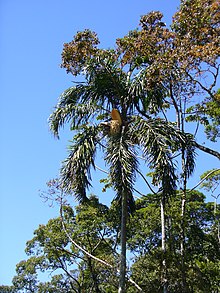
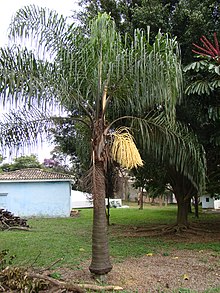
fruit
The fruits often resemble those of the coconut palm and are often edible. They are small to quite large and each contain one, rarely two seeds. They are spherical, egg-shaped or ellipsoidal and of green, brown, yellow or reddish color. Some fruits are beaked. The perianth and staminodial ring remain at the base and sometimes enlarge into a cupula. The exocarp is smooth or striped, glabrous or hairy. The mesocarp is fleshy or dry and has numerous longitudinal fibers. The endocarp is thick, woody, and has three (rarely four) basal pores. The endocarp cavity is irregularly shaped or more often circular, rarely triangular in cross-section with three conspicuous, vertical lines. The seed corresponds to the shape of the endocarp cavity, attaches subbasally to the fruit. The endosperm is homogeneous or ruminate and sometimes has a central cavity. The embryo is basal or subbasal opposite one of the endocarp pores.
Distribution and locations
The genus is restricted to South America with one exception. Here it occurs from Venezuela south to Argentina. Most of the species are found in Brazil. One species ( Syagrus amara ) occurs in the Lesser Antilles .
Most species are restricted to arid to semi-arid areas, including all stemless species. A few species, mainly the tree-like, are restricted to mesian to tropical rainforests. The trunkless species are a characteristic part of several Brazilian arid vegetation types, such as cerrado or campo rupestre .
Systematics
The genus Syagrus is placed within the palm family in the subfamily Arecoideae , Tribus Cocoseae and Subtribus Attaleinae. Closely related genera within this subtribe are Lytocaryum and Attalea . The genus is probably polyphyletic, but a detailed phylogenetic study of the Attaleinae is missing.
In Brazil, where several species occur sympatric, natural hybrids are formed. Where in culture Syagrus romanzoffiana and Butia capitata grow together, hybrids also form.
The genus name Syagrus was already used for a palm in antiquity, as was the case by Pliny, but not for the New World genus now called this. The genus was first described by Carl Friedrich Philipp von Martius in 1824, the type species is Syagrus cocoides . In the past, the species that are now part of Syagrus were divided into several genera, which were separated from Syagrus due to their ruminate endosperm. However, this has proven to be an unreliable differentiator. With the first edition of Genera Palmarum in 1987, the species of these genera were added to Syagrus . An investigation by the Tribus Cocoseae 2004 [3] showed that Syagrus is polyphyletic. Since only three species of the genus were represented in this work, the delimitation of a monophyletic genus Syagrus and a separation of new genera is not possible.
The Royal Botanic Gardens, Kew's World Checklist of Selected Plant Families recognizes the following species and hybrids:
- Syagrus allagopteroides Noblick & Lorenzi : Brazil.
- Syagrus × altopalacioensis K.Soares & LCAssis = Syagrus duartei × Syagrus pleioclada
- Syagrus amara (Jacq.) Mart. : Lesser Antilles.
- Syagrus amicorum K.Soares & CAGuim : The species first described in 2019 occurs in Brazil.
- Syagrus × andrequiceana K.Soares & LCAssis = Syagrus flexuosa × Syagrus romanzoffiana
- Syagrus angustifolia Noblick & Lorenzi : Brazil.
- Syagrus botryophora (Mart.) Mart. : Eastern Brazil.
- Syagrus caerulescens Noblick & Lorenzi : Brazil.
- Syagrus campestris (Mart.) H. Wendl. : Brazil.
- Syagrus × campos-portoana (Bondar) Glassman = Syagrus coronata × Syagrus romanzoffiana
- Syagrus campylospatha (Barb. Rodr.) Becc. : Brazil and Paraguay.
- Syagrus cardenasii Glassman : Bolivia.
- Syagrus cataphracta (Mart.) Noblick : Brazil.
- Syagrus cearensis Noblick : Northeastern Brazil.
- Syagrus cerqueirana Noblick & Lorenzi : Brazil and Paraguay.
- Syagrus × cipoensis K.Soares & LCAssis = Syagrus glaucescens × Syagrus oleracea
- Syagrus cocoides Mart. : Guyana and Brazil.
- Syagrus comosa (Mart.) Mart. : Bolivia and Brazil.
- Syagrus coronata (Mart.) Becc. : Northeastern Brazil.
- Syagrus × costae Glassman = Syagrus cearensis × Syagrus coronata
- Syagrus deflexa Noblick & Lorenzi : Brazil.
- Syagrus duartei Glassman : Brazil.
- Syagrus elata (LRMoreno & OIMoreno) Noblick : Bolivia.
- Syagrus emasensis Noblick & Lorenzi : Brazil.
- Syagrus evansiana Noblick : Brazil.
- Syagrus flexuosa (Mart.) Becc. : Eastern Bolivia and Brazil.
- Syagrus glaucescens Glaz. ex Becc. : Brazil.
- Syagrus glazioviana (Dammer) Becc. : Brazil.
- Syagrus gouveiana Noblick & Lorenzi : Brazil.
- Syagrus graminifolia (Drude) Becc. : Brazil. With three subspecies.
- Syagrus guaratingensis Noblick : The species first described in 2018 occurs in Brazil.ref name = "WCSP" />
- Syagrus guimaraesensis Noblick & Lorenzi : Brazil.
- Syagrus harleyi Glassman : Brazil.
- Syagrus hoehnei Burret : Brazil.
- Syagrus inajai (Spruce) Becc. : Northern South America to northern and northeastern Brazil.
- Syagrus insignis (Devansaye) Becc. : Brazil.
- Syagrus itacambirana Noblick & Lorenzi : Brazil.
- Syagrus itapebiensis (Noblick & Lorenzi) Noblick & Meerow : Brazil.
- Syagrus kellyana Noblick & Lorenzi : Brazil.
- Syagrus × lacerdamourae K.Soares & CAGuim. = Syagrus botryophora × Syagrus coronata
- Syagrus lilliputiana ( Barb . Rodr .) Becc. : Brazil and Eastern Paraguay.
- Syagrus loefgrenii Glassman : Brazil.
- Syagrus longipedunculata Noblick & Lorenzi : Brazil.
- Syagrus lorenzoniorum Noblick & Lorenzi : Brazil.
- Syagrus macrocarpa Barb. Rodr. : Brazil.
- Syagrus × matafome (Bondar) ADHawkes = Syagrus coronata × Syagrus vagans
- Syagrus mendanhensis Glassman : Brazil.
- Syagrus menzeliana Noblick & Lorenzi : Brazil.
- Syagrus microphylla Burret : Brazil.
- Syagrus minor Noblick & Lorenzi : Brazil.
- Syagrus × mirandana Noblick = Syagrus coronata × Syagrus microphylla
- Syagrus oleracea (Mart.) Becc. : Bolivia, Brazil and northeastern Paraguay.
- Syagrus orinocensis (Spruce) Burret : Southern Colombia, Venezuela, and Northern Brazil.
- Syagrus petraea (Mart.) Becc. : Eastern Bolivia.
- Syagrus picrophylla Barb . Rodr . : Brazil.
- Syagrus pimentae Noblick : Brazil.
- Syagrus pleioclada Burret : Brazil.
- Syagrus pleiocladoides Noblick & Lorenzi : Brazil.
- Syagrus pompeoi K.Soares & RSPimenta : Brazil.
- Syagrus procumbens Noblick & Lorenzi : Brazil.
- Syagrus pseudococos (Raddi) Glassman : Southeastern Brazil.
- Syagrus romanzoffiana (Cham.) Glassman : Brazil, Paraguay, Uruguay and northeastern Argentina.
- Syagrus rupicola Noblick & Lorenzi : Brazil.
- Syagrus ruschiana (Bondar) Glassman : Brazil.
- Syagrus sancona (Kunth) H.Karst. : Western South America to Venezuela and northwestern Brazil.
- Syagrus santosii K.Soares & CAGuim. : Brazil.
- Syagrus schizophylla (Mart.) Glassman : Brazil.
- Syagrus × serroana K.Soares & LCAssis = Syagrus glaucescens × Syagrus romanzoffiana
- Syagrus smithii (HEMoore) Glassman : Southeast Colombia to northern Peru and northern Brazil.
- Syagrus stenopetala Burret : Northern Venezuela.
- Syagrus stratincola Wess.Boer : Guiana, French Guiana, Suriname, and northern Brazil.
- Syagrus × teixeiriana Glassman = Syagrus oleracea × Syagrus romanzoffiana
- Syagrus × tostana (Bondar) Glassman = Syagrus coronata × Syagrus schizophylla
- Syagrus vagans (Bondar) ADHawkes : Brazil.
- Syagrus vermicularis Noblick : Brazil.
- Syagrus weddelliana (H. Wendl.) Becc. : Brazil.
- Syagrus werdermannii Burret : Brazil.
- Syagrus yungasensis M.Moraes : Bolivia.
use
The leaves of a number of species are used for palm leaf roofs , the dark brown ouricuri wax , which has similar properties to carnauba wax , is obtained from the leaves of the wax palm Syagrus coronata . The mesocarp of Syagrus oleracea and Syagrus coronata is edible, and palm oil can be obtained from the endosperm of Syagrus cocoides and Syagrus coronata . The wood of the trunks is used in many ways. Several species are used as ornamental plants.
literature
- John Dransfield, Natalie W. Uhl, Conny B. Asmussen, William J. Baker, Madeline M. Harley, Carl E. Lewis: Genera Palmarum. The Evolution and Classification of Palms. Second edition, Royal Botanic Gardens, Kew 2008, ISBN 978-1-84246-182-2 , pp. 423-428.
Individual evidence
- ^ A b Robert Lee Riffle, Paul Craft: An Encyclopedia of Cultivated Palms. 4th edition, Timber Press, Portland 2007, ISBN 978-0-88192-558-6 , pp. 454 f.
- ↑ a b c d e f g h i j k l m n o p q r s t u v w x y z aa ab ac ad ae af ag ah ai aj ak al am an ao ap aq ar as at au av aw ax ay az ba bb bc bd be bf bg bh bi bj bk bl bm bn bo Rafaël Govaerts (Ed.): Syagrus. In: World Checklist of Selected Plant Families (WCSP) - The Board of Trustees of the Royal Botanic Gardens, Kew . Retrieved April 16, 2020.
- ^ Maria Perla Colombini, Francesca Modugno: Organic Mass Spectrometry in Art and Archeology. Wiley, 2009, ISBN 978-0-470-74192-4 , p. 11.
Web links
- Syagrus on the homepage of the Fairchild Tropical Botanic Garden





